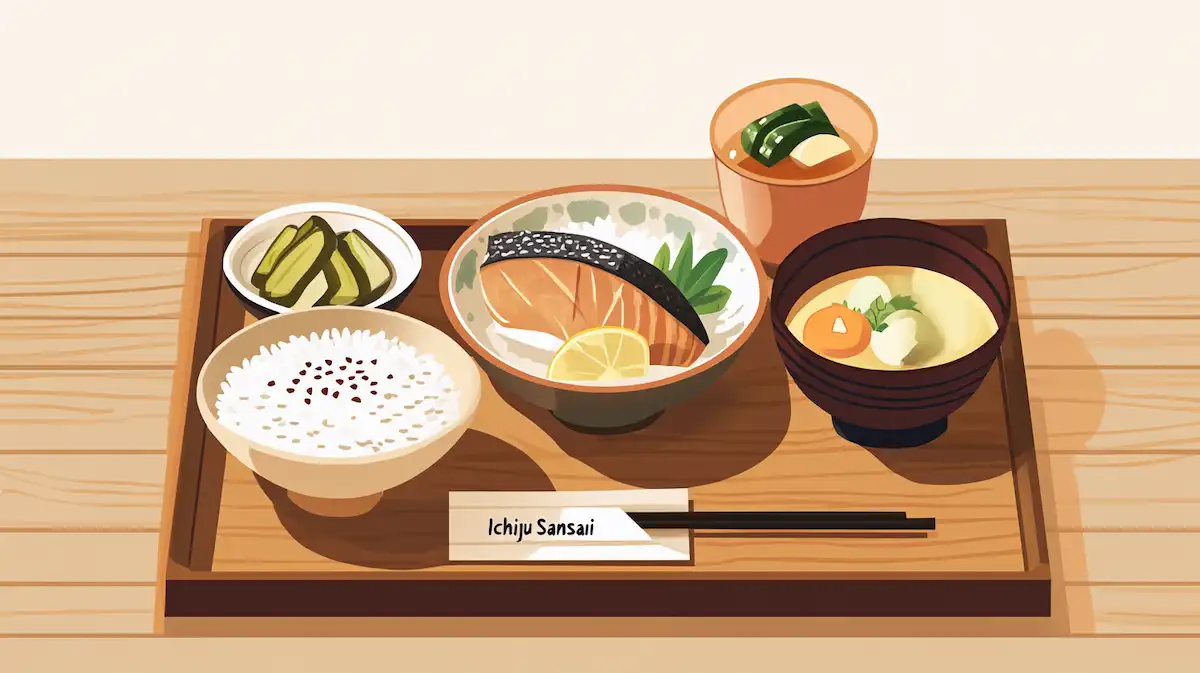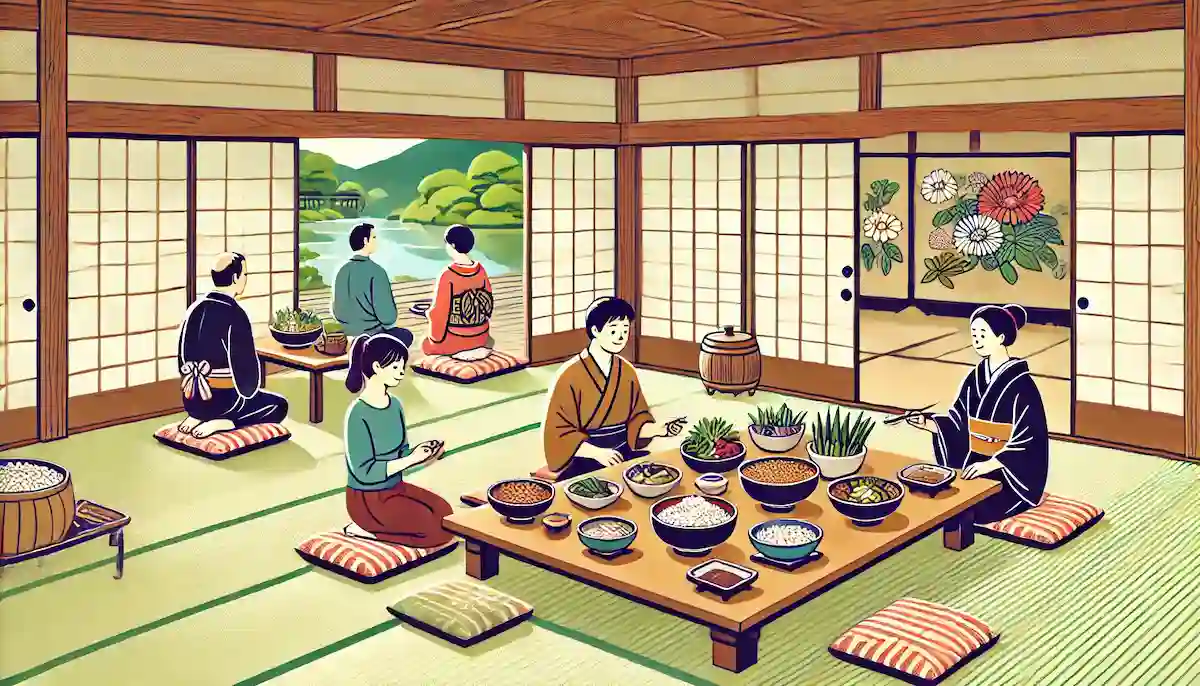精進料理を英語で説明・紹介するための基本情報と、英会話に役立つ表現をシンプルでわかりやすい英語で紹介します。
英会話ダイアローグ・関連情報・10の質問を通して、精進料理に関する英語表現を学びます。
英語
英会話ダイアローグを読む前に知っておくと良い前提知識と情報は以下の通りです。
- 精進料理の定義:
- 精進料理は仏教の教えに基づく日本の伝統的な菜食料理
- 肉や魚を使用せず、野菜、穀物、豆類、海藻などの植物性食材のみを使用
- 主な特徴:
- 五葷(にんにく、ねぎ、にら、らっきょう、たまねぎ)を避ける
- 煮る、焼く、蒸す、揚げる、生のままの五つの調理法を駆使
- 代表的な料理:
- 天ぷら、煮物、胡麻豆腐、湯葉、お吸い物
- 健康効果:
- 植物性食品を使用するため、ビタミンやミネラルが豊富で低脂肪
- 高い食物繊維含有量で消化に良い
- 抗酸化物質が豊富で細胞を保護
- 有名な地域:
- 京都、奈良、高野山、鎌倉、兵庫(丹波)
- 寺院や宿坊(寺院に併設された宿泊施設)で提供されることが多い
2人が精進料理について話しています。
精進料理の特徴、代表的な料理、精進料理の有名な地域や寺院などを話題にしています。
会話 / dialogue

Hey Key, have you ever tried Shojin Ryori? I’ve recently become interested in it.

Yes, I have! It’s fascinating how it’s deeply connected to Buddhist culture. What sparked your interest?

I read about it and learned that it’s a vegetarian cuisine with no meat or fish, only plant-based ingredients like vegetables, grains, beans, and seaweed.

Exactly. It’s often served in temples and shukubo, which are temple lodgings. Did you know that places like Kyoto and Nara are famous for Shojin Ryori?

Yes, I found out that Kyoto’s temples like Nanzen-ji and Daitoku-ji, and Nara’s Todai-ji are well-known for their Shojin Ryori. I’m actually planning to visit one of these places soon.

That sounds great! Mount Koya is another excellent spot. You can stay overnight in a shukubo and experience the monks’ lifestyle, including their meals.

I’ve heard that too. The food is beautifully presented and uses seasonal ingredients. It’s not just healthy but also a spiritual experience.

True. The dishes are usually low in fat and rich in vitamins and minerals. However, some people might find the flavors too mild or the lack of meat less satisfying.

Yes, that’s one downside. But the balanced nutrition and the variety of dishes like tempura, nimono, and goma tofu make up for it, I think.

Definitely. I love how Shojin Ryori brings out the natural flavors of the ingredients. And it’s not just about eating; it’s a way to practice mindfulness.

Absolutely. I recently bought a book on Shojin Ryori and tried making some dishes at home. It was time-consuming but very rewarding.

That’s amazing! It can be a bit challenging to master the recipes, but it’s worth the effort.

I agree. It’s a beautiful way to connect with Japanese culture and improve my cooking skills.

For sure. Let me know if you need any tips or recipes. I’d love to help.

Thanks, Key. I appreciate it. Let’s try making some Shojin Ryori together next time.

Sounds like a plan. I’m looking forward to it!

By the way, have you visited any specific temples for Shojin Ryori?

Yes, I’ve been to a few in Kyoto. Each temple has its own unique take on Shojin Ryori. It’s a great experience.

That sounds exciting. I’ll definitely make a detailed plan for my visit.

You won’t regret it. It’s an unforgettable experience!
関連情報 / related information
「精進料理」について、理解を深めるための「英語での関連情報」です。
精進料理

What is Shojin Ryori?
Shojin Ryori is a traditional Japanese vegetarian cuisine. It is based on Buddhist teachings and does not use any meat or fish. Instead, it uses plant-based ingredients like vegetables, grains, beans, and seaweed. This type of food is often eaten by monks as part of their practice.
Features of Shojin Ryori
Shojin Ryori avoids using five pungent vegetables: garlic, onions, leeks, chives, and scallions. It focuses on a balance of colors and nutrients in the dishes. The food is prepared using five main cooking methods: boiling, grilling, steaming, frying, and raw.
Typical Dishes
Some typical dishes in Shojin Ryori include tempura (fried vegetables and seaweed), nimono (vegetables and beans cooked in broth), goma tofu (tofu made from sesame seeds), yuba (skin from heated soy milk), and osuimono (simple soup with broth). These dishes are known for their simple yet rich flavors.
Health Benefits
Shojin Ryori is very healthy. It is low in fat and rich in vitamins and minerals. The high fiber content is good for digestion. The use of many vegetables and seaweed provides antioxidants that protect the body’s cells.
Famous Places
Shojin Ryori is famous in places like Kyoto, Nara, Mount Koya, Kamakura, and Tamba in Hyogo. You can often enjoy it at temples and shukubo (temple lodgings). Eating Shojin Ryori in these places is a unique and peaceful experience.
10の質問 / 10 questions
「精進料理」について、理解を深めるための「英語での10の質問」です。
1: What is Shojin Ryori?
Shojin Ryori is a traditional Japanese vegetarian cuisine that follows Buddhist teachings. It uses only plant-based ingredients like vegetables, grains, beans, and seaweed.
2: Where is Shojin Ryori usually served?
Shojin Ryori is often served in temples and temple lodgings, known as shukubo. It is also popular in regions like Kyoto, Nara, and Mount Koya.
3: Why does Shojin Ryori avoid certain vegetables?
Shojin Ryori avoids five pungent vegetables like garlic, onions, and leeks because they are believed to disturb the mind and hinder meditation in Buddhist practices.
4: What are some common dishes in Shojin Ryori?
Common dishes include tempura (fried vegetables), nimono (vegetables cooked in broth), goma tofu (sesame tofu), and yuba (tofu skin).
5: Is Shojin Ryori healthy?
Yes, Shojin Ryori is considered very healthy because it is low in fat, rich in vitamins and minerals, and high in fiber, which aids digestion.
6: Can you eat Shojin Ryori outside of temples?
Yes, you can find Shojin Ryori in specialized restaurants, especially in cities like Kyoto and Nara, but it is most commonly served at temples and shukubo.
7: What does Shojin Ryori emphasize in cooking?
Shojin Ryori emphasizes the natural flavors of the ingredients and focuses on balance, using five colors and five cooking methods: boiling, grilling, steaming, frying, and raw.
8: How does Shojin Ryori reflect Buddhist teachings?
Shojin Ryori reflects Buddhist teachings by promoting mindfulness, respect for all life, and simplicity, avoiding the harm of animals and strong flavors that could disturb concentration.
9: Can tourists experience Shojin Ryori?
Yes, many tourists can experience Shojin Ryori by staying at shukubo or visiting temples that offer it, especially in famous locations like Mount Koya or Kyoto.
10: What is the significance of seasonal ingredients in Shojin Ryori?
Seasonal ingredients are important in Shojin Ryori because they reflect the natural cycle of life and help create dishes that are fresh, flavorful, and in harmony with the environment.
和訳付
会話 / dialogue

Hey Key, have you ever tried Shojin Ryori? I’ve recently become interested in it.
ねえキー、精進料理を食べたことある?最近興味を持ち始めたんだ。

Yes, I have! It’s fascinating how it’s deeply connected to Buddhist culture. What sparked your interest?
うん、あるよ!仏教文化と深く結びついているのが興味深いよね。どうして興味を持ったの?

I read about it and learned that it’s a vegetarian cuisine with no meat or fish, only plant-based ingredients like vegetables, grains, beans, and seaweed.
調べたら、肉や魚を使わない菜食料理で、野菜、穀物、豆類、海藻だけを使うって知ったんだ。

Exactly. It’s often served in temples and shukubo, which are temple lodgings. Did you know that places like Kyoto and Nara are famous for Shojin Ryori?
その通り。精進料理は寺院や宿坊でよく提供されているよ。京都や奈良が精進料理で有名だって知ってた?

Yes, I found out that Kyoto’s temples like Nanzen-ji and Daitoku-ji, and Nara’s Todai-ji are well-known for their Shojin Ryori. I’m actually planning to visit one of these places soon.
うん、南禅寺や大徳寺、奈良の東大寺が精進料理で有名だって分かったんだ。実は近いうちにそのどれかを訪れる予定なんだ。

That sounds great! Mount Koya is another excellent spot. You can stay overnight in a shukubo and experience the monks’ lifestyle, including their meals.
それはいいね!高野山も素晴らしい場所だよ。宿坊に泊まって、僧侶の生活や食事を体験できるんだ。

I’ve heard that too. The food is beautifully presented and uses seasonal ingredients. It’s not just healthy but also a spiritual experience.
それも聞いたことがあるよ。料理の見た目が美しくて、季節の食材を使っているんだって。健康的なだけでなく、精神的な体験でもあるよね。

True. The dishes are usually low in fat and rich in vitamins and minerals. However, some people might find the flavors too mild or the lack of meat less satisfying.
そうだね。料理は通常、低脂肪でビタミンやミネラルが豊富なんだ。でも、味が淡白すぎるとか、肉がないと満足できないって感じる人もいるかもしれないね。

Yes, that’s one downside. But the balanced nutrition and the variety of dishes like tempura, nimono, and goma tofu make up for it, I think.
そう、それが一つの欠点だね。でも、天ぷらや煮物、胡麻豆腐みたいなバランスの取れた栄養と多様な料理がその分を補っていると思うよ。

Definitely. I love how Shojin Ryori brings out the natural flavors of the ingredients. And it’s not just about eating; it’s a way to practice mindfulness.
本当にそうだね。精進料理が素材の自然な味を引き出すところが好きだよ。それに、食べることだけじゃなくて、マインドフルネスを実践する方法でもあるんだ。

Absolutely. I recently bought a book on Shojin Ryori and tried making some dishes at home. It was time-consuming but very rewarding.
まったくその通り。最近精進料理の本を買って、自宅でいくつかの料理を作ってみたんだ。時間はかかったけど、とてもやりがいがあったよ。

That’s amazing! It can be a bit challenging to master the recipes, but it’s worth the effort.
それはすごいね!レシピをマスターするのは少し難しいけど、その価値はあるよ。

I agree. It’s a beautiful way to connect with Japanese culture and improve my cooking skills.
同感だよ。日本文化とつながる美しい方法だし、料理のスキルも向上するよね。

For sure. Let me know if you need any tips or recipes. I’d love to help.
もちろん。アドバイスやレシピが必要なら教えてね。手伝うよ。

Thanks, Key. I appreciate it. Let’s try making some Shojin Ryori together next time.
ありがとう、キー。感謝するよ。今度一緒に精進料理を作ってみよう。

Sounds like a plan. I’m looking forward to it!
いいね。楽しみにしているよ!

By the way, have you visited any specific temples for Shojin Ryori?
ところで、精進料理のために特定の寺院を訪れたことはある?

Yes, I’ve been to a few in Kyoto. Each temple has its own unique take on Shojin Ryori. It’s a great experience.
うん、京都のいくつかの寺院に行ったことがあるよ。どの寺院も独自の精進料理を提供していて、素晴らしい体験だったよ。

That sounds exciting. I’ll definitely make a detailed plan for my visit.
それは楽しそうだね。訪れるための詳細な計画を立てるよ。

You won’t regret it. It’s an unforgettable experience!
後悔しないよ。忘れられない体験になるから!
関連情報 / related information
精進料理

What is Shojin Ryori?
Shojin Ryori is a traditional Japanese vegetarian cuisine. It is based on Buddhist teachings and does not use any meat or fish. Instead, it uses plant-based ingredients like vegetables, grains, beans, and seaweed. This type of food is often eaten by monks as part of their practice.
精進料理は、日本の伝統的な菜食料理です。仏教の教えに基づいており、肉や魚を使用しません。代わりに、野菜、穀物、豆類、海藻などの植物性食材を使用します。この種類の食事は、僧侶が修行の一環として食べることが多いです。
Features of Shojin Ryori
Shojin Ryori avoids using five pungent vegetables: garlic, onions, leeks, chives, and scallions. It focuses on a balance of colors and nutrients in the dishes. The food is prepared using five main cooking methods: boiling, grilling, steaming, frying, and raw.
精進料理は、にんにく、たまねぎ、ねぎ、にら、そしてらっきょうの五葷(ごくん)を避けます。料理の色彩と栄養のバランスに重点を置いています。調理法には、煮る、焼く、蒸す、揚げる、生のままという五つの方法を使用します。
Typical Dishes
Some typical dishes in Shojin Ryori include tempura (fried vegetables and seaweed), nimono (vegetables and beans cooked in broth), goma tofu (tofu made from sesame seeds), yuba (skin from heated soy milk), and osuimono (simple soup with broth). These dishes are known for their simple yet rich flavors.
精進料理の代表的な料理には、天ぷら(野菜と海藻の揚げ物)、煮物(だしで煮込んだ野菜と豆類)、胡麻豆腐(ごまから作られた豆腐)、湯葉(温めた豆乳の皮)、そしてお吸い物(だしのシンプルなスープ)があります。これらの料理は、シンプルながらも豊かな風味で知られています。
Health Benefits
Shojin Ryori is very healthy. It is low in fat and rich in vitamins and minerals. The high fiber content is good for digestion. The use of many vegetables and seaweed provides antioxidants that protect the body’s cells.
精進料理は非常に健康的です。脂肪が少なく、ビタミンやミネラルが豊富です。高い食物繊維含有量は消化に良いです。多くの野菜と海藻の使用により、体の細胞を保護する抗酸化物質を提供します。
Famous Places
Shojin Ryori is famous in places like Kyoto, Nara, Mount Koya, Kamakura, and Tamba in Hyogo. You can often enjoy it at temples and shukubo (temple lodgings). Eating Shojin Ryori in these places is a unique and peaceful experience.
精進料理は、京都、奈良、高野山、鎌倉、兵庫県の丹波などの場所で有名です。これらの場所では、寺院や宿坊(寺院の宿泊施設)で精進料理を楽しむことができます。これらの場所で精進料理を食べることは、ユニークで平和な体験です。
10の質問 / 10 questions
1: What is Shojin Ryori?
精進料理とは何ですか?
Shojin Ryori is a traditional Japanese vegetarian cuisine that follows Buddhist teachings. It uses only plant-based ingredients like vegetables, grains, beans, and seaweed.
精進料理は仏教の教えに基づく日本の伝統的な菜食料理です。野菜、穀物、豆類、海藻など植物性の食材のみを使用します。
2: Where is Shojin Ryori usually served?
精進料理はどこで提供されますか?
Shojin Ryori is often served in temples and temple lodgings, known as shukubo. It is also popular in regions like Kyoto, Nara, and Mount Koya.
精進料理は寺院や宿坊でよく提供されます。京都、奈良、高野山などの地域でも人気があります。
3: Why does Shojin Ryori avoid certain vegetables?
なぜ精進料理は特定の野菜を避けるのですか?
Shojin Ryori avoids five pungent vegetables like garlic, onions, and leeks because they are believed to disturb the mind and hinder meditation in Buddhist practices.
精進料理では、にんにく、たまねぎ、ねぎなどの五葷を避けます。これらは心を乱し、仏教の瞑想の妨げになると信じられています。
4: What are some common dishes in Shojin Ryori?
精進料理の代表的な料理には何がありますか?
Common dishes include tempura (fried vegetables), nimono (vegetables cooked in broth), goma tofu (sesame tofu), and yuba (tofu skin).
代表的な料理には、天ぷら(野菜の揚げ物)、煮物(だしで煮た野菜)、胡麻豆腐(ごま豆腐)、湯葉(豆腐の皮)があります。
5: Is Shojin Ryori healthy?
精進料理は健康的ですか?
Yes, Shojin Ryori is considered very healthy because it is low in fat, rich in vitamins and minerals, and high in fiber, which aids digestion.
はい、精進料理は非常に健康的とされています。脂肪が少なく、ビタミンやミネラルが豊富で、食物繊維が多く含まれているため、消化を助けます。
6: Can you eat Shojin Ryori outside of temples?
寺院以外でも精進料理を食べることはできますか?
Yes, you can find Shojin Ryori in specialized restaurants, especially in cities like Kyoto and Nara, but it is most commonly served at temples and shukubo.
はい、精進料理は専門のレストランでも見つけられます。特に京都や奈良などの都市では多いですが、最も一般的には寺院や宿坊で提供されます。
7: What does Shojin Ryori emphasize in cooking?
精進料理では料理において何を重視しますか?
Shojin Ryori emphasizes the natural flavors of the ingredients and focuses on balance, using five colors and five cooking methods: boiling, grilling, steaming, frying, and raw.
精進料理は食材の自然な風味を重視し、五色と五法(煮る、焼く、蒸す、揚げる、生のまま)でバランスを取ります。
8: How does Shojin Ryori reflect Buddhist teachings?
精進料理はどのように仏教の教えを反映していますか?
Shojin Ryori reflects Buddhist teachings by promoting mindfulness, respect for all life, and simplicity, avoiding the harm of animals and strong flavors that could disturb concentration.
精進料理は、マインドフルネス、すべての生命への敬意、そしてシンプルさを促進することで、仏教の教えを反映しています。動物の殺傷や集中を乱す強い風味を避けます。
9: Can tourists experience Shojin Ryori?
観光客も精進料理を体験できますか?
Yes, many tourists can experience Shojin Ryori by staying at shukubo or visiting temples that offer it, especially in famous locations like Mount Koya or Kyoto.
はい、多くの観光客が宿坊に泊まったり、精進料理を提供する寺院を訪れたりして体験できます。特に高野山や京都などの有名な場所で楽しめます。
10: What is the significance of seasonal ingredients in Shojin Ryori?
精進料理における季節の食材の重要性は何ですか?
Seasonal ingredients are important in Shojin Ryori because they reflect the natural cycle of life and help create dishes that are fresh, flavorful, and in harmony with the environment.
季節の食材は、精進料理において生命の自然な循環を反映し、料理を新鮮で風味豊かにし、環境との調和を保つのに役立ちます。
words & phrases
英会話ダイアローグと関連情報に出てきた単語・フレーズです(例文は各3つ)。

nutrition : 名詞
意味: 栄養、栄養学。The process of providing or obtaining the food necessary for health and growth.
(精進料理の健康効果を説明する際に使用)
例文
- Good nutrition is essential for a healthy life.
「良い栄養は健康な生活に不可欠です。」 - The nutrition in vegetables and grains is very beneficial.
「野菜や穀物の栄養は非常に有益です。」 - She studied nutrition to become a dietitian.
「彼女は栄養学を学んで栄養士になりました。」
rewarding : 形容詞
意味: やりがいのある、報われる。Providing satisfaction; gratifying.
(精進料理を作ることが時間がかかるが、その努力が報われることを表す)
例文
- Teaching is a very rewarding profession.
「教職は非常にやりがいのある職業です。」 - Completing the project was extremely rewarding.
「プロジェクトを完成させることは非常にやりがいがありました。」 - Volunteering at the shelter is rewarding.
「シェルターでボランティアをすることはやりがいがあります。」
pungent : 形容詞
意味: 強烈な、刺激的な。Having a sharply strong taste or smell.
(精進料理で避けられる五葷(にんにく、たまねぎなど)の強い匂いを説明するために使用)
例文
- The pungent smell of garlic filled the kitchen.
「にんにくの強い匂いがキッチンに広がりました。」 - The cheese has a pungent flavor.
「そのチーズは強烈な風味があります。」 - The pungent aroma of spices was unmistakable.
「スパイスの刺激的な香りは間違えようがありませんでした。」
grilling : 名詞
意味: グリルすること、焼くこと。The act of cooking food on a grill.
(精進料理の調理方法の一つとして使用)
例文
- Grilling vegetables can bring out their natural sweetness.
「野菜をグリルすると自然な甘みが引き出されます。」 - We enjoy grilling outdoors during the summer.
「夏には屋外でのグリルを楽しみます。」 - He is an expert in grilling meats.
「彼は肉のグリルの名人です。」
digestion : 名詞
意味: 消化、消化作用。The process by which the body breaks down food into small components that can be absorbed.
(精進料理の高い食物繊維含有量が消化に良いことを説明するために使用)
例文
- Proper digestion is essential for good health.
「適切な消化は健康にとって不可欠です。」 - Fiber is important for good digestion.
「食物繊維は良い消化のために重要です。」 - The doctor recommended a diet that aids digestion.
「医師は消化を助ける食事を勧めました。」
詳細情報 / Further Info
関連記事(和食、高野山:宿坊体験と精進料理)


